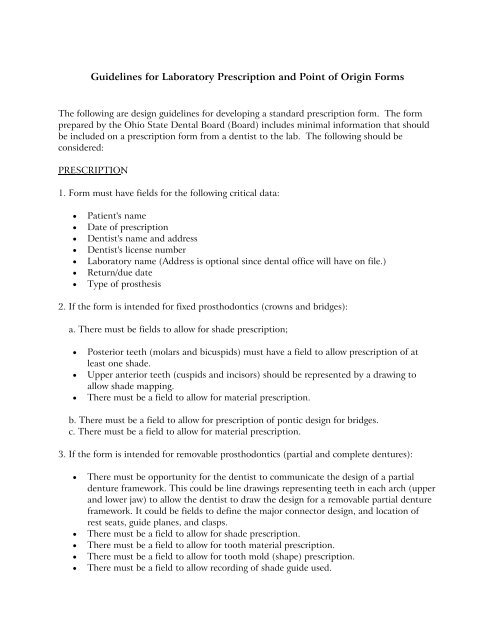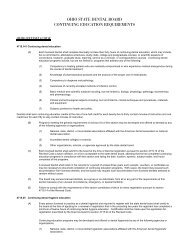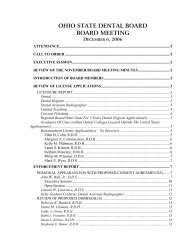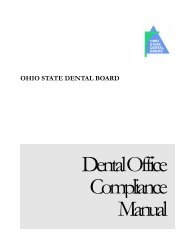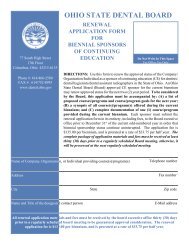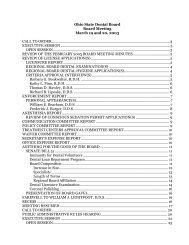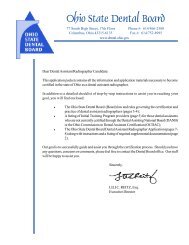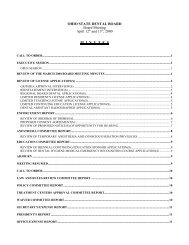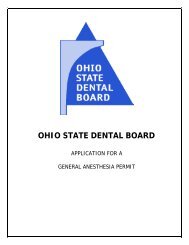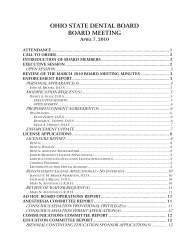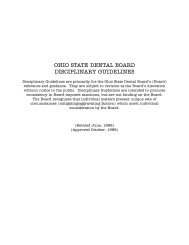Guidelines for Laboratory Prescription and Point of Origin Forms
Guidelines for Laboratory Prescription and Point of Origin Forms
Guidelines for Laboratory Prescription and Point of Origin Forms
You also want an ePaper? Increase the reach of your titles
YUMPU automatically turns print PDFs into web optimized ePapers that Google loves.
<strong>Guidelines</strong> <strong>for</strong> <strong>Laboratory</strong> <strong>Prescription</strong> <strong>and</strong> <strong>Point</strong> <strong>of</strong> <strong>Origin</strong> <strong>Forms</strong><br />
The following are design guidelines <strong>for</strong> developing a st<strong>and</strong>ard prescription <strong>for</strong>m. The <strong>for</strong>m<br />
prepared by the Ohio State Dental Board (Board) includes minimal in<strong>for</strong>mation that should<br />
be included on a prescription <strong>for</strong>m from a dentist to the lab. The following should be<br />
considered:<br />
PRESCRIPTION:<br />
1. Form must have fields <strong>for</strong> the following critical data:<br />
• Patient's name<br />
• Date <strong>of</strong> prescription<br />
• Dentist's name <strong>and</strong> address<br />
• Dentist's license number<br />
• <strong>Laboratory</strong> name (Address is optional since dental <strong>of</strong>fice will have on file.)<br />
• Return/due date<br />
• Type <strong>of</strong> prosthesis<br />
2. If the <strong>for</strong>m is intended <strong>for</strong> fixed prosthodontics (crowns <strong>and</strong> bridges):<br />
a. There must be fields to allow <strong>for</strong> shade prescription;<br />
• Posterior teeth (molars <strong>and</strong> bicuspids) must have a field to allow prescription <strong>of</strong> at<br />
least one shade.<br />
• Upper anterior teeth (cuspids <strong>and</strong> incisors) should be represented by a drawing to<br />
allow shade mapping.<br />
• There must be a field to allow <strong>for</strong> material prescription.<br />
b. There must be a field to allow <strong>for</strong> prescription <strong>of</strong> pontic design <strong>for</strong> bridges.<br />
c. There must be a field to allow <strong>for</strong> material prescription.<br />
3. If the <strong>for</strong>m is intended <strong>for</strong> removable prosthodontics (partial <strong>and</strong> complete dentures):<br />
• There must be opportunity <strong>for</strong> the dentist to communicate the design <strong>of</strong> a partial<br />
denture framework. This could be line drawings representing teeth in each arch (upper<br />
<strong>and</strong> lower jaw) to allow the dentist to draw the design <strong>for</strong> a removable partial denture<br />
framework. It could be fields to define the major connector design, <strong>and</strong> location <strong>of</strong><br />
rest seats, guide planes, <strong>and</strong> clasps.<br />
• There must be a field to allow <strong>for</strong> shade prescription.<br />
• There must be a field to allow <strong>for</strong> tooth material prescription.<br />
• There must be a field to allow <strong>for</strong> tooth mold (shape) prescription.<br />
• There must be a field to allow recording <strong>of</strong> shade guide used.
<strong>Laboratory</strong> Form <strong>Guidelines</strong><br />
Page 2<br />
4. If the <strong>for</strong>m is to be used <strong>for</strong> orthodontics (retainer or removable or fixed orthodontic<br />
prosthesis) or occlusal splints (bite plates to protect teeth or treat TMJ problems):<br />
• There must be opportunity <strong>for</strong> the doctor to explicitly define the type <strong>of</strong> prosthesis.<br />
This can be a checklist or blank space that would enable the doctor to write.<br />
• There must be opportunity <strong>for</strong> the doctor to define explicit instructions. This can be a<br />
checklist or blank space that would enable the doctor to write.<br />
5. All <strong>for</strong>ms should allow the doctor space to write explicit instructions.<br />
POINT OF ORIGIN:<br />
6. The dentist should be aware <strong>of</strong> where the device is being fabricated. The point <strong>of</strong> origin<br />
in<strong>for</strong>mation should be included, <strong>and</strong> should be returned to the prescribing dentist to allow<br />
the dentist to review all in<strong>for</strong>mation <strong>and</strong> make an in<strong>for</strong>med decision on behalf <strong>of</strong> the patient.


